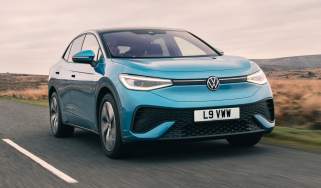Volkswagen ID.4 review - Range, charging & running costs
"The Volkswagen ID.4 can go a long way on a charge, and a range of battery sizes are expected"
The ID.4 is underpinned by the same MEB platform as the ID.3 hatchback, albeit stretched to suit its bigger proportions. Battery sizes are 52kWh and 77kWh, with the larger size fitted as standard on all but the entry-level model.
Volkswagen ID.4 range & charging
The largest pack is capable of an official range of up to 349 miles from a single charge in the ID.4 Match Pro. Go for the four-wheel-drive Pro 4Motion and the extra grip comes at the expense of range, which drops to an official 326 miles.
The ID.4 GTX has an official range of 319 miles, but the range we had when we tested the car in colder temperatures was around 230 miles, while warmer weather increased this to 262 miles.
In cheaper versions with the 52kWh battery fitted, the car's official range figure drops to just 222 miles. It’s a real shame that all versions of the ID.4 come without a heat pump as standard – this works to condition the battery to optimal operating temperatures in all weather – if it gets cold and you don’t have a heat pump, your battery’s range is likely to be negatively affected. Many rivals offer this as standard, so take this into consideration before you buy.
More reviews
The ID.4 has 135kW charging capacity, so if you can find a fast enough charger, it can be replenished by almost 200 miles in half an hour. The Volvo gets 150kW charging as standard but is a more expensive car to buy in the first place, however, the Hyundai Ioniq 5 costs less and charges at up to 232kW. During our time with the GTX model, we found that a 20-minute charge added around 90 miles of range when using a rapid charger at motorway services.
Like other electric models, the ID.4 is more expensive to buy than a petrol or diesel equivalent but you start saving money as soon as you own it, particularly if you have a home wallbox charger. There's VED (road tax) exemption until April 2025, from which point electric cars will have to start paying too. Company-car drivers also stand to save money, because Benefit-in-Kind tax is far cheaper for zero-emission models.
Insurance groups
Unfortunately, insurance groups tend to be higher for upmarket, electric models. The ID.4 starts in group 29, while the top-spec GTX sits in group 34. The Kia Niro EV sits in similar groups with all versions in group 29 out of 50. The base model Renault Scenic sits one group lower in 28, but all other versions of this car sit in group 32.
Warranty
The Volkswagen ID.4 is covered by the brand's standard three-year/60,000-mile warranty, however, early EV adopters will be reassured that the battery gets a longer, eight-year/100,000-mile period of cover. Some buyers have been put off buying an electric car because of the unknown reliability of batteries and the fact they make up such a large proportion of an electric vehicle's value.
Servicing
Electric vehicles don't require as much maintenance as their petrol, diesel or hybrid counterparts. There's no oil or spark plugs for a start, and no clutch or cambelt to replace. However, they do still require some work to ensure the braking system, climate control and other systems are maintained and functioning correctly, so Volkswagen requires owners to service the ID.4 every two years, with no mileage cap between visits.
Which Is Best?
Cheapest
- Name125kW Match Pure 52kWh 5dr Auto [19'' Alloys]
- Gearbox typeAuto
- RRP£39,580
Most Economical
- Name250kW 4MOTION GTX Edition 79kWh 5dr Auto
- Gearbox typeAuto
- RRP£52,825
Fastest
- Name250kW 4MOTION GTX Edition 79kWh 5dr Auto
- Gearbox typeAuto
- RRP£52,825












